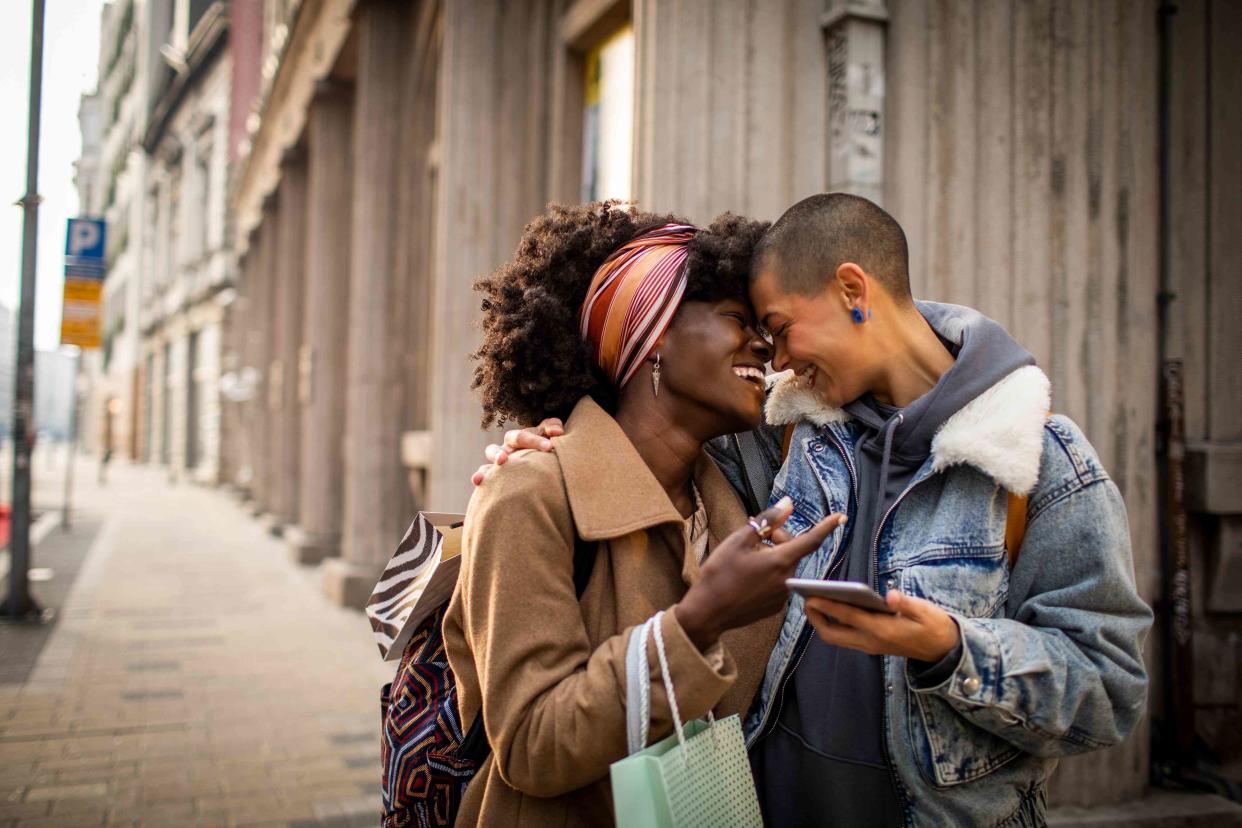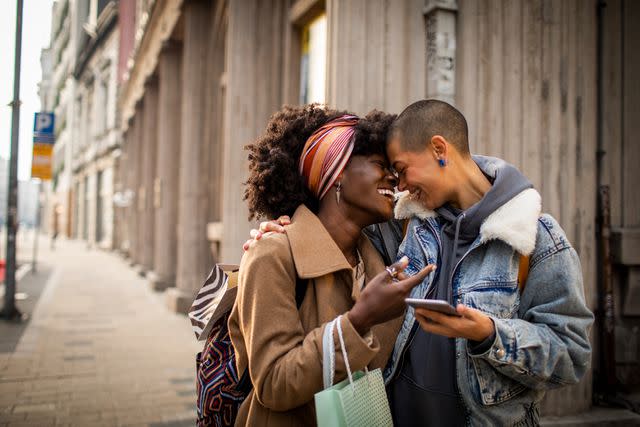An Explanation of Omnisexual vs. Pansexual Attraction

Marko Geber / Getty Images
Medically reviewed by Lauren Schlanger, MD
Pansexual people are physically, emotionally, and romantically attracted to any person, regardless of that person’s gender identity or sexual orientation. Omnisexual people are also attracted to people across the gender and sexual orientation spectrums.
This article will explain how pansexuality differs from omnisexuality. You’ll also gain insight into the subtle differences in how attraction for people of these gender identities looks, coming to terms with your gender identity, how to open up the conversation about your gender identity to others if you choose, and resources that can offer support and information.

Marko Geber / Getty Images
How Pansexuality Is Different From Omnisexuality
Pansexual and omnisexual people are attracted to all genders, but how they view or make sense of this attraction differs. The terms are sometimes used interchangeably, but there is a subtle distinction. Pansexuality is different from omnisexuality in that pansexual persons may consider their attraction to be gender-blind.
Origins of Pansexuality and Omnisexuality
The term “pansexual” originates from the Greek prefix “pan” meaning “all.” It has been used since the early 20th century, and has origins in abnormal psychology. The term's meaning has evolved over time to represent not an abnormality but a difference or preference. Omnisexuality, on the other hand, is a more recent term stemming from Latin origin in which the prefix "omni" means "all."
The Subtle Distinction
Pansexual people are attracted to other people regardless of gender identity, while omnisexual people are attracted to all gender identities. Pansexuality is sometimes referred to as gender blindness, but omnisexuality is not.
What Is Gender Blindness?
Gender blindness is a gender-based ideology in which a person doesn’t see or acknowledge the differences among genders. Critics of gender blindness in institutions and workplaces may argue that it erases the real impact of gender ideology and gender-based violence on gender minorities, which includes transgender persons and people under the bi+ (beyond bisexual) umbrella.
Proponents may argue gender blindness may help fight against gender-based biases, including transphobia and sexism.
Related: What’s the Difference Between Bisexuality and Pansexuality?
Attraction in Pansexualit
Pansexual people may not be attracted to someone based on gender or sexuality (i.e., their attraction is independent of gender). However, they can still have preferences in who they find attractive.
The pansexual pride flag first appeared online in 2010. Although the exact origin of the flag isn’t clear, the pansexual pride flag represents how attraction in pansexuality works (and how it differs from bisexuality). The Gender and Sexuality Resource Center at the University of Northern Colorado (GSRC) explains what the colors, from top to bottom, represent:
Pink represents attraction to women.
Yellow represents attraction to those who identify as genderqueer, non-binary, agender, or androgynous.
Blue represents attraction to men.
Related: Gender Identity
Attraction in Omnisexuality
Attraction in omnisexuality is slightly different. Omnisexual people are attracted to all genders, but gender does play a role in this attraction. Omnisexual people can still have preferences when it comes to attraction.
The omnisexual pride flag is said to have first appeared on Tumblr in July 2016, with the note that it could be interchanged with the pansexual pride flag, but offering no explanation of what the colors mean. The original flag design, attributed to @pastelmemer, showed five stripes.
From top to bottom, they are: light pink, pink, black, blue, and light blue. The colors have since been explained based on omnisexual attraction as follows:
Light pink and light blue represent the gender spectrum.
Pink represents attraction to femininity and women.
Blue represents attraction to masculinity and men.
Dark purple represents attraction to people whose gender falls outside of the categories above.
Related: What Is Gender Non-Conforming?
Can You Be Both?
Pansexuality and omnisexuality are both terms that fall under the bi+ or beyond bisexual umbrella. However, due to the subtle differences in how pansexual people and omnisexual people view gender, being both pansexual and omnisexual at the same time technically is not possible.
Gender ideology can change as more is learned about the gender spectrum. A person could change how they identify (pansexual vs. omnisexual) if their view on gender changes.
Gender vs Sexuality
Gender identity and sexuality are talked about together a lot, but they are very different terms. Gender is a social construct that exists on a spectrum. It is about how you see yourself in the world. Sexuality is about how you see other people in the world, and who (if anyone) you find attractive.
If you are questioning your gender, support is available. Some great resources include The Trevor Project, The Gender Unicorn, and the Transgender Law Center.
Coming to Terms With Your Sexuality
Coming to terms with your sexuality can be a process that looks quite different for everyone. Some people may be certain of their sexuality from a young age, whereas others may question, explore, and evolve their understanding of their sexual identity over their lifetime.
Questioning your sexuality is a healthy part of working toward coming to terms with your sexuality. If you're struggling with the concept of pride due to fear of pansexual or omnisexual stigma, you're also not alone in this. People who fall under the bi+ umbrella are less likely to be out than gay people and are at a higher risk for mental health struggles, as well as intimate partner violence.
Some helpful resources geared toward coming to terms with bi+ sexuality specifically include:
Peer Support Space Inc. (Florida)
Bisexual Organizing Project (Minneapolis)
Harriet Hancock LGBT Center’s Bi+ Space (South Carolina)
Takeaway
If you have suicidal thoughts, dial 988 to contact the 988 Suicide & Crisis Lifeline and connect with a trained counselor. If you or a loved one is in immediate danger or feel like you may be in a position to hurt yourself or others, call 911 immediately.
How to Start a Conversation With Others
Studies have shown that concealing your bi+ identity may have negative mental health outcomes, including risk of internalized stigma, rejection sensitivity, anxiety, and depression. Talking about it can help and conversations about your sexuality can be started in any way you feel comfortable.
However, you are under no obligation to have these conversations. Coming to terms with your sexuality doesn’t have to follow some script. You can take your time, talk to whomever you feel comfortable with, or reach out to groups and people who you know will be open-minded and safe people to talk with.
There are safe spaces you can use to start conversations with others about your sexuality. Some resources include:
Visiting a local LGBTQ+ community center
Joining live chats with peers at Q Chat Space
Checking out LGBTQ-focused organizations such as the Human Rights Campaign (HRC), The Trevor Project, and Parents and Friends of Lesbians and Gays (PFLAG)
Summary
"Pansexuality" and "omnisexuality" are terms under the bi+ umbrella of sexual identity. While they are sometimes used interchangeably, they refer to subtly different sexual identities. Pansexual people are attracted to people of all genders but this attraction occurs independent of gender.
Omnisexual people are attracted to people of all genders based on their gender expression. People who are attracted to all genders can still have preferences in who they find attractive. Coming to terms with your sexuality looks different for everyone. If you're questioning your sexual preferences, or are not sure how you feel, it's important to talk to someone you trust, or seek a safe support system.
Read Next: Gender-Affirming Care Bans Harm More Than Just the Trans Community

